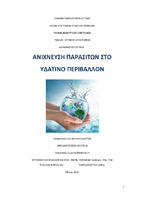| dc.contributor.advisor | Βογιατζάκη, Χρυσάνθη | |
| dc.contributor.advisor | Τσουμάνη, Μαρία | |
| dc.contributor.author | Δρόσου, Βασιλική | |
| dc.date.accessioned | 2022-05-12T10:31:49Z | |
| dc.date.available | 2022-05-12T10:31:49Z | |
| dc.date.issued | 2022-03-03 | |
| dc.identifier.uri | https://polynoe.lib.uniwa.gr/xmlui/handle/11400/2229 | |
| dc.identifier.uri | http://dx.doi.org/10.26265/polynoe-2080 | |
| dc.description.abstract | Στην παρούσα διπλωματική εργασία διερευνήθηκαν τα παράσιτα που υπάρχουν στο υδάτινο περιβάλλον, τόσο στο θαλάσσιο όσο και στο γλυκό νερό. Έμφαση δόθηκε στην μόλυνση που έχει υποστεί το υδάτινο περιβάλλον που την τελευταία δεκαετία φαίνεται να έχει αυξηθεί σημαντικά. Τα αποτελέσματα της μόλυνσης στην ύπαρξη και στην κατανομή των παρασίτων είναι ένα άλλο ενδιαφέρον πεδίο της «Περιβαλλοντικής Παρασιτολογίας» που προσελκύει αυξανόμενο ενδιαφέρον. Στα πρόσφατα χρόνια, υπάρχει ένας αυξανόμενος αριθμός μελετών που δείχνει πως η μόλυνση και ο παρασιτισμός μπορούν να αλληλεπιδράσουν μεταξύ τους στους υδάτινους οργανισμούς με τις επιδράσεις τους να είναι είτε συνεργατικές, πρόσθετες είτε και ανταγωνιστικές με ιδιαίτερο ενδιαφέρον να παρουσιάζει η υγεία των υδάτινων ξενιστών. Ακόμα μελετήθηκε η επίδραση των ρύπων στην αφθονία των παρασίτων, τα παράσιτα ως αποδέκτες των ρύπων καθώς και οι επιδράσεις των παρασίτων στους βιοδείκτες και τη φυσιολογία του ξενιστή. Στην συνέχεια, μελετήθηκαν τα παράσιτα ως διαφορετικοί βιολογικοί δείκτες και πιο συγκεκριμένα το πώς τα παράσιτα εμφανίζονται ως δείκτες επίδρασης και συσσώρευσης αλλά και ως δείκτες για την κλιματική αλλαγή. Όσο αφορά, τους δείκτες συσσώρευσης έγινε πιο ενδελεχή μελέτη, και έτσι εξετάστηκαν ποια η χρησιμότητα τους, ποια συστήματα ξενιστή-παρασίτου θα ήταν κατάλληλα για παρακολούθηση, ποιοι περιορισμοί υπάρχουν στη χρήση παρασίτων ψαριών ως δείκτες και αν χρειαζόμαστε καινούριους δείκτες. Επιπλέον, μελετήθηκε η συγκέντρωση των βαρέων μετάλλων μεταξύ των παρασίτων και των ξενιστών μέσω του παράγοντα βιοσυγκέντρωσης (BCF= C[Παρασίτου]/ C[Ιστού ξενιστή]) για να βρεθεί η σχέση που υπάρχει στα βαρέα μέταλλα μεταξύ των παρασίτων και των ξενιστών και με βάση τα αποτελέσματά τα παράσιτα θα μπορούσαν να φανούν χρήσιμα ως βιοδείκτες όταν αξιολογούμε την περιβαλλοντική μόλυνση στα υδάτινα οικοσυστήματα για βαρέα μέταλλα. Τέλος, αναφέρονται οι διαφορετικές μέθοδοι ανίχνευσης των παρασίτων (Cryptosporidium, Giardia, Toxoplasma gondii, Acanthamoeba, Naegleria Fowleri, Cyclospora Cayetanensis, Blastocystis) σε ότι αφορά το υδάτινο περιβάλλον με τα τελευταία χρόνια να έχουμε σημαντική πρόοδο στην ανάπτυξη μοριακών μεθόδων. | el |
| dc.format.extent | 62 | el |
| dc.language.iso | el | el |
| dc.publisher | Πανεπιστήμιο Δυτικής Αττικής | el |
| dc.rights | Αναφορά Δημιουργού - Μη Εμπορική Χρήση - Παρόμοια Διανομή 4.0 Διεθνές | * |
| dc.rights | Attribution-NonCommercial-NoDerivatives 4.0 Διεθνές | * |
| dc.rights.uri | http://creativecommons.org/licenses/by-nc-nd/4.0/ | * |
| dc.subject | Παράσιτα | el |
| dc.subject | Υδάτινη ρύπανση | el |
| dc.subject | Βιολογικοί δείκτες | el |
| dc.subject | Ανίχνευση πρωτοζώων | el |
| dc.title | Ανίχνευση παρασίτων στο υδάτινο περιβάλλον | el |
| dc.title.alternative | Detection of parasites in aquatic environment | el |
| dc.type | Πτυχιακή εργασία | el |
| dc.contributor.committee | Βογιατζάκη, Χρυσάνθη | |
| dc.contributor.committee | Τσουμάνη, Μαρία | |
| dc.contributor.committee | Αδαμοπούλου, Μαρία | |
| dc.contributor.faculty | Σχολή Επιστημών Υγείας & Πρόνοιας | el |
| dc.contributor.department | Τμήμα Βιοϊατρικών Επιστημών | el |
| dc.description.abstracttranslated | In the current thesis, the parasites present in the aquatic environment, both in marine and freshwater, were investigated and thoroughly examined. An emphasis was placed on the pollution of the aquatic environment where the pollution has increased the last decade. Effects of pollution on the occurrence and distribution of parasites is another interesting field of “Environmental Parasitology” attracting increasing attention. In recent years there has been an increasing number of papers showing how parasitism and pollution can interact with each other in aquatic organisms with their effects to be either cooperative, additional or competitive with special interest to be shown into the health of the aquatic hosts. Moreover, the effect of pollutants in the abundance of parasites was studied, the parasites as receivers of pollutants as well as the effects of parasites at the biomarkers and the physiology of the host. Afterwards, the parasites were studied as different biological indicators and more specifically how the parasites are presented as effect and accumulation indicators and also as indicators for the climate change. For the accumulation indicators became a more thorough study and thus it was examined their usefulness, which systems host-parasite would be suitable for monitoring, which restrictions there are in the use of fish parasite as indicators and if we need new indicators. Furthermore, the concentration of heavy metals between the parasites and the hosts was studied through the bioconcentration factor (BCF= C[Parasite]/ C[Host tissue]) in order to be found the relation that there is in heavy metals between parasites and hosts and according to the results parasites could be useful as bioindicators when we evaluate the environmental pollution in aquatic ecosystems for heavy metals. In the end, the different detection methods of parasites (Cryptosporidium, Giardia, Toxoplasma gondii, Acanthamoeba, Naegleria Fowleri, Cyclospora Cayetanensis, Blastocystis) in aquatic environment are reported where molecular methods have shown progress over the last years. | el |


